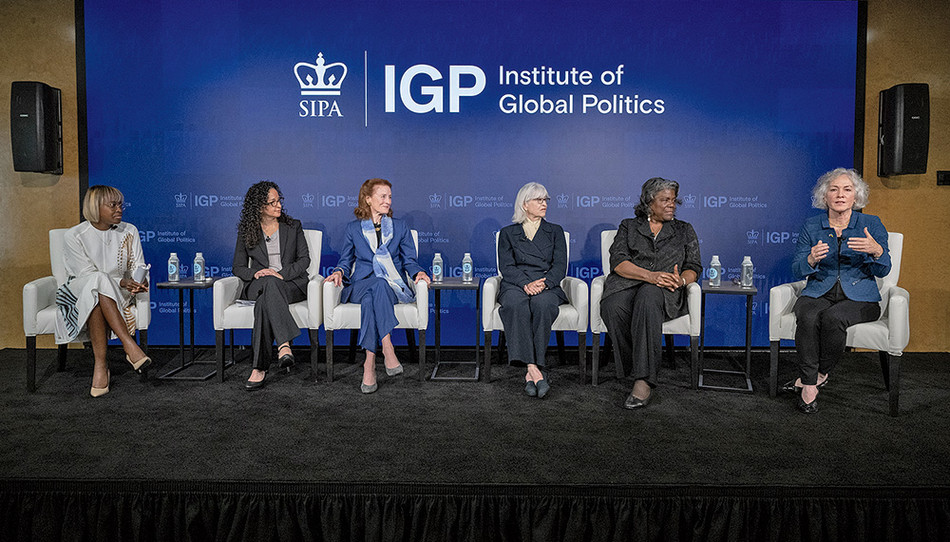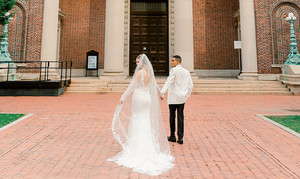
On a Wednesday afternoon this past September, more than 350 students, having passed their required Secret Service background checks and charged their smartphones for picture-taking, filed into Altschul Auditorium in the International Affairs Building with something more than the usual excitement that accompanies the first day of class. Chosen from eight hundred applicants from the School of International and Public Affairs, Columbia College, Barnard College, and the School of General Studies, these future diplomats, policymakers, intelligence analysts, foreign-service officers, and civic leaders had come to attend the most talked-about course of the year. As the auditorium filled up, the students opened their laptops but kept their eyes expectantly on the stage, which held twin lecterns and a couple of stylish white chairs.
The course, called Inside the Situation Room, would be taught by two Columbia professors: Keren Yarhi-Milo ’03GS, the dean of SIPA and an expert in political psychology and international security, and Hillary Rodham Clinton ’22HON, a former first lady, US senator, and US secretary of state, who joined SIPA last year as a professor of practice. Yarhi-Milo and Clinton had worked closely over the summer, planning lessons that would take students inside the black box of crisis decision-making at the highest levels of government, from the pursuit of Osama bin Laden to nuclear negotiations with Iran. And given that day’s charged headlines — Russia’s war on Ukraine, China’s military exercises off Taiwan, North Korea’s missile tests, a speakerless House, and more — the class couldn’t help but be timely.
Shortly after 2:00 p.m., Yarhi-Milo and Clinton walked onto the stage and the room erupted in applause (“It’s not normal for the students to applaud when the professors enter the classroom,” Yarhi-Milo said later, “and I’m under no illusion that they’re clapping for me”). But just beneath the heady atmosphere of celebrity was a sense of gravity about the geopolitical perils of the moment, unfolding in an age of climate disaster, rising autocracy, intense partisanship, and nuclear threat. “Every year, I teach a version of this class,” Yarhi-Milo said in her opening remarks, “and it always feels like, ‘This is the best year to teach a class on foreign policy.’” That drew knowing chuckles. There are plenty of foreign-policy crises out there, she said, and they often serve as useful examples of the theories discussed in the class.
Yarhi-Milo, who came to SIPA in 2019 after a decade at Princeton, studies how leaders make decisions. Her work draws on insights from behavioral economics, psychology, game theory, and history. But that afternoon she confessed to her own limitations as a scholar: “I get to this point where I say, ‘Well, that’s as much as I can tell you, because I was not in the room’ … So we are extremely fortunate to have somebody who was in the room, making those decisions, to be with us and talk through the tradeoffs, the process, the different considerations that came into each and every decision.”
As secretary of state under President Barack Obama ’83CC, Clinton had sat down in rooms from Beijing to Baghdad, Kinshasa to Kabul, Moscow to Manila, São Paulo to Seoul. But one room she hadn’t been in for about fifty years was the classroom. Yet it was immediately evident from her ease and command at the lectern that her decades in politics had prepared her well for the professoriate (Yarhi-Milo calls her “a natural”).
“You are going to think really hard about how leaders make decisions,” Clinton told the class. “What were the alternatives? What information was he or she given? How were other factors outside the so-called Situation Room at work in influencing not only the leader but the people around the leader, who may have had their own agendas?” Those other factors, such as individual psychology, personal biases, political calculations, bureaucratic limitations, and public pressure, complicate the effort to assess the intentions of your counterpart across the table.
“You are going to think really hard about how leaders make decisions,” Clinton told the class. “What were the alternatives? What information was he or she given?”
Clinton gave a salient example: the Russian military buildup on the Ukrainian border that preceded the invasion of February 2022. Some decision-makers had fallen into what Clinton called the “rationality trap,” in which they considered this to be mere saber-rattling, since it would be irrational for Putin to launch an unprovoked attack. “There was so much disbelief: it’s 2022, why on earth would Russia invade Ukraine? It made no rational sense.” It was only the Biden administration’s “unprecedented decision” to declassify intelligence about Russian troop movements and show it to allies, said Clinton, that proved to the Ukrainians and to NATO that “the irrational may well happen.”
Both Clinton and Yarhi-Milo are avid students of modern US diplomacy, and their combined expertise — Yarhi-Milo discusses the various theories of international relations, and Clinton illustrates them with historical examples, some of them firsthand — gives students a rare portal into world events. In the first class alone, they touched on the Cuban Missile Crisis, the Suez Crisis, the Six-Day War, the Yom Kippur War, the Iran nuclear agreement, the Paris climate agreement, and the US withdrawal from Afghanistan. They introduced students to such thinkers as Thomas Schelling, a leading exponent of coercion theory, which examines military threats as ways to deter or compel another state’s actions; the psychologists Daniel Kahneman and Amos Tversky, whose 1979 paper “Prospect Theory: An Analysis of Decision Under Risk” posited that people feel the pain of losses more intensely than the pleasure of equal gains, an insight that reshaped how foreign-policy analysts interpret threats and behavior (and which led to a Nobel Prize); and Robert Jervis, a longtime Columbia professor and towering political scientist who put the personal perceptions of individual leaders at the heart of foreign relations, influencing a generation of scholars, including Yarhi-Milo.
Clinton, meanwhile, having headed the State Department from 2009 to 2013, could speak intimately about high-pressure situations in which life-and-death decisions had to be made, and fast. As the syllabus notes, the Situation Room “metaphorically travels with policymakers as they encounter different kinds of crises,” whether military, political, diplomatic, or humanitarian. The literal Situation Room, located in the West Wing, was created in 1961 to funnel intelligence directly to the White House. That’s where Clinton was on May 1, 2011, during the US Navy SEAL raid to kill Osama bin Laden.
“I was part of the small group that was analyzing the intelligence and then had the responsibility of making a recommendation to President Obama,” Clinton told the class. “We had information. Did we have the right information? Did we have enough information?” To find out, they tasked two teams in the intelligence community with assessing the data and were told that there was a 40 to 60 percent chance that a man they had spotted in bin Laden’s compound was bin Laden. “Is 40 percent enough to do something?” Clinton asked, giving a real taste of the stakes. “Is 60 percent enough to do something?”
These were the kinds of problems that she wanted students to think hard about. Ultimately, Obama made the decision to go ahead: the raid took forty minutes, bin Laden was shot and killed in a firefight, and there were no US casualties. But today, Clinton warned, deepfake artificial intelligence has added more layers of potential deception to the hunt for accurate data, taking disinformation campaigns, she said, “to an astronomical new level of difficulty.”
And then there is the problem of subjectivity — the idiosyncratic psychologies of human beings that inform crisis decision-making. Students are encouraged to wrestle with complexity and deploy empathy and imagination in order to transport themselves, as Yarhi-Milo said, “into the shoes of the leaders — looking at the situation from their perspective, with the information they had.” The focus here is on process, not outcome: “This is not,” she emphasized, “a class about who got it right or wrong.”
Yarhi-Milo grew up in Holon, Israel, just south of Tel Aviv, in a region where issues of security and diplomacy are part of daily life. In 1993, the year she turned fifteen, three things happened that would shape her future. First, in January, the new US president, Bill Clinton, appointed Madeleine Albright ’76GSAS, ’95HON to be ambassador to the UN. Second, that same month, a secret back-channel meeting between two Israeli professors and three officials of the Palestine Liberation Organization (PLO) took place in Oslo, Norway — negotiations that would culminate that September at the White House, where President Clinton, Israeli prime minister Yitzhak Rabin, and PLO chairman Yasser Arafat would sign the Oslo Accords, which granted self-government to Palestinians in the West Bank and the Gaza Strip. “That was the period that I became very interested in diplomacy and thinking about international relations in a different way, beyond what was happening in Israel or in the Middle East,” Yarhi-Milo says. “I read a lot about US foreign policy.” Third, she visited New York with her mother, who took her to see the Columbia campus. Knowing that Ambassador Albright had a Columbia degree, Yarhi-Milo grabbed a course catalog and vowed to return there someday as a student. “That was the dream,” she says.
By the time Albright was confirmed as secretary of state in 1997, becoming, at that point, the highest-ranking woman ever in US government, Yarhi-Milo was fulfilling her mandatory service in the Israel Defense Forces, where she worked in intelligence with a focus on the peace process. After her service, she went to New York for an internship with the Israeli mission to the United Nations. There she met her future husband, Ariel Milo ’03GS, who was then a student at Columbia’s School of General Studies. Yarhi-Milo was thrilled to learn that Columbia had an undergraduate college for nontraditional students who had spent their post-high-school years in the military. She met with then GS dean Peter Awn — a Harvard PhD in Islamic religion and the son of Lebanese Christian immigrants — and they hit it off, talking in depth about religion and politics. Yarhi-Milo had found her intellectual home.
At GS, she took a class with Robert Jervis, whose groundbreaking 1976 book Perception and Misperception in International Politics looked at how decision-makers draw inferences from information — especially information that contradicts their views. “Political science is largely about finding patterns, identifying key variables that produce those patterns, and applying a theory that can explain the patterns and maybe even predict them,” Yarhi-Milo says. “But it’s also about the human factor — the psychology of leaders. That’s the part that I find most fascinating.”
After getting her PhD from the University of Pennsylvania, Yarhi-Milo became a professor at Princeton and published the acclaimed books Knowing the Adversary: Leaders, Intelligence, and Assessment of Intentions in International Relations and Who Fights for Reputation: The Psychology of Leaders in International Conflict. As a tenured woman professor in international relations at Princeton, she was lavished with offers. But everyone knew what she was waiting for.
“When Columbia called, I said, ‘Absolutely,’” Yarhi-Milo says. “This is my home. There’s no other place.” She joined the political-science department and SIPA in 2019, briefly reuniting, this time as colleagues, with her mentor Jervis, who died in 2021. The following year, Columbia President Lee C. Bollinger ’71LAW, ’02HON, nearing the end of his twenty-one-year presidency, appointed Yarhi-Milo dean of SIPA.
Bollinger was also instrumental in bringing the former secretary of state, whom he’d known for years, to Columbia. One day in late 2022, he hosted an event for Clinton at the President’s House and introduced her to a number of deans. The last dean she met was Yarhi-Milo. The two women clicked. For one thing, Clinton had read Yarhi-Milo’s work and found that it rang true to her own experience in the field. “We started this back-and-forth,” says Yarhi-Milo, “and everybody in the room was just looking at us, wondering, ‘What’s going on there?’”
“When we met,” says Clinton, “we immediately connected. We saw these massive challenges in the world and talked about the ways we could design an institute to address them.” The conversation excited Clinton, and she says Yarhi-Milo played a big role in drawing her to Columbia. Another major factor was location. “New York is home to the United Nations and close to many world-class academic centers,” Clinton says. “This was a chance to give fellows and students direct involvement in global policymaking. That connectivity really appealed to me.”
In January 2023, Bollinger announced that Clinton would join the faculty of SIPA.
The academy has long been a common starting and landing place for State Department heads. Condoleezza Rice, secretary of state under George W. Bush, teaches at Stanford. George Shultz ’01HON (Ronald Reagan) taught economics at MIT. Henry Kissinger (Richard Nixon, Gerald Ford) taught at Harvard. Dean Rusk ’63HON (John F. Kennedy, Lyndon B. Johnson) was the dean of faculty at Mills College, in Oakland, before he became secretary of state and afterward joined the law faculty at the University of Georgia. Madeleine Albright taught at Georgetown before her service and at Columbia after. And Clinton herself had taught at the University of Arkansas School of Law in the mid-1970s.
Now, with half a century of domestic and global political experience to her name, Clinton, in partnership with Yarhi-Milo, jumped straight into the dream project they had talked about that day at the President’s House. Working closely and intensely, they fused their talents to create the nonpartisan Institute of Global Politics (IGP), a hub where scholars and practitioners would produce work to address real-world problems in domestic and foreign relations — work that they could get into the hands of policymakers. During her years in government, Clinton found that leaders had little access to the latest research and ideas from academia. There was no real policy pipeline between the classroom and the Situation Room. She wanted to change that.
Yarhi-Milo calls the IGP “the living embodiment of SIPA’s mission.” She and Clinton assembled, in cooperation with the Carnegie Endowment for International Peace, a cohort of fourteen Carnegie Distinguished Fellows (among them: Stacey Abrams, voting-rights activist and former Georgia House minority leader; Henrietta Fore, former executive director of UNICEF; Frank Mugisha, Ugandan LGBTQ+ advocate; and John Sullivan ’85LAW, former deputy secretary of state) to meet with SIPA students and develop policy proposals with faculty across the University.
The IGP held its inaugural summit on October 3, 2023. The program featured panel discussions with scholars, diplomats, politicians, journalists, and organizational leaders, including Nobel Prize–winning Columbia economist Joseph Stiglitz, President Minouche Shafik, former secretary of the treasury and current SIPA professor Jack Lew (now US ambassador to Israel), Columbia law professor Timothy Wu, New York governor Kathy Hochul (a Democrat), former Maryland governor Larry Hogan (a Republican), US ambassador to the UN Linda Thomas-Greenfield, Nobel Peace Prize–winning journalist and IGP fellow Maria Ressa, and former US ambassador to Ukraine and IGP fellow Marie Yovanovitch, as well as a one-on-one conversation between Clinton and former New Zealand prime minister Jacinda Ardern. The panels addressed the global economy, artificial intelligence, the modeling of respectful, across-the-aisle discourse, and, not least, the ways women shape diplomacy.
“To achieve our mission to effect change, we must include women every step of the way.”
“Women are disproportionately affected by so many of our global challenges, from the effects of climate change to gendered violence in conflict zones,” Clinton says. “They are also underrepresented in the rooms where people purport to try and solve these challenges, whether it be the halls of government or academia. Yet many of the most visionary responses to climate change are being implemented by women. Women are contributing to peace processes and national security. So, quite simply, to achieve our mission to effect change, we must include women every step of the way.”
At the summit, women diplomats enumerated their attributes. “Women have superpowers: one is listening, and one is compassion,” said Yovanovitch, who as ambassador to Ukraine testified before Congress during President Donald Trump’s first impeachment over his attempted extortion of Ukrainian president Volodymyr Zelensky. She also pointed to the “really superb work ethic” that women bring to the Foreign Service. “We have to work twice as hard in order to get to where we need to go,” she said, “and we don’t get the same benefit of the doubt, even today.”
Another panelist, the prominent diplomat A. Elizabeth Jones, said that women “make the Foreign Service a better place. We have to listen, ask a lot of questions, have to figure out what’s going on with the people we’re talking to in order to understand where they’re coming from, so we can formulate our advocacy needs in ways that meet their needs and wants. We can’t go in and harangue and shake our finger — that’s not going to change behavior.”
Yarhi-Milo expanded on that. “When polarization infects our political discourse and corrodes our ability to enact meaningful policy, when future leaders have been allowed to cluster in silos instead of being exposed to new ideas, when the space to talk about policy, including foreign policy, is becoming narrower and narrower, leading to dangerous groupthink, we need an entirely new approach,” she said. “For our students to become effective leaders, we have to teach them not how to articulate their own beliefs but how to listen to others.”
Four days after the IGP summit, on October 7, Hamas militants entered Israel, killed some 1,200 Israelis, and kidnapped more than two hundred people. This triggered devastating Israeli attacks on Gaza, which touched off a humanitarian disaster and angry demonstrations around the world. Here was a decades-long struggle whose resolution had eluded every diplomatic overture ever made.
The following Wednesday, the chatter in the Altschul Auditorium was noticeably louder. The violence had exposed profound divisions on campus, and some of that tension had seeped into a lecture hall filled with the world’s future policymakers and peacemakers. Yarhi-Milo had foretold that world events might merge with the course material, though no one could have anticipated anything like this.
The dean came out and faced the class. Though deeply shaken by events, she remained composed and measured, acknowledging the attack and the retaliatory strikes and the suffering on all sides. She urged students to exercise empathy and compassion in their interactions with each other and reaffirmed SIPA’s role as a policy school whose job in a crisis of this magnitude was to produce real-time analysis and foster conversations “that are civil and respectful and professional.”
After the lecture, which dealt with the concepts of reputation and credibility among leaders and countries, Yarhi-Milo allotted extra time for students to ask questions, and here some of the day’s emotions inevitably surfaced. Students from various backgrounds complained of double standards and bias in the way the conflict was being judged. In the end, it was Clinton who got the last word. “The empathy that Keren talked about is needed now more than ever,” she told the class. “It doesn’t mean you agree with someone, but it does mean that at least you hear them out and do the best you can to try to find some common point of humanity.
“That’s what we are hoping will be part of the response of people here at SIPA, which is the largest policy school in the US, the most diverse, the most international. If we can’t figure out how to have respectful conversations that include disagreement, but also to practice empathy, what hope do we have for the rest of the world?”
As the worldwide protests over the war in Gaza continued through the semester, Inside the Situation Room proceeded on track and on schedule, covering such urgent geopolitical issues as intervention (what factors influence the choice of whether to intervene in a crisis?), red lines and credibility (what happens when a leader fails to back up a promise or a threat?), the risk factors of clandestine missions, the role and impact of women on peacemaking and national security, intelligence failures (featuring a guest lecture from SIPA adjunct professor Peter Clement, a former CIA senior official), and humanitarian crises, including the one unfolding in real time in Gaza.
In addition, the IGP held webinars, conversations, and interviews that addressed not just the Middle East but also international human rights, cybersecurity, and — a recurring theme at IGP — the search for common ground in politics, which begins with the recognition of a shared humanity. In a time of “radical uncertainty,” says Yarhi-Milo, the central task for world leaders must be “to build resilience and optimism.”
And while optimism may be in short supply for many of us, it is, as Yarhi-Milo and Clinton make clear, the precondition for conducting diplomacy — and for teaching it.
“I often borrow a phrase from my late friend Madeleine Albright and say that I’m an optimist who worries a lot,” Clinton says. “I come to teach at Columbia every week, and I talk to students who are trying to make a better world, who are energetic and smart and compassionate. And I think we owe it to them not to give in to hopelessness.
“So I remain optimistic, because to do otherwise would be to give up on the chance, every day, to help even one woman access health care, to send even one girl to school in a place where only boys have access to education, or to lay one brick in a foundation of diplomacy that ends a conflict. We keep moving forward because that’s what we owe those who did it before us and who will after us.”
The course Inside the Situation Room will be available for purchase online in spring 2024, with all proceeds going toward SIPA financial aid.
This article appears in the Winter 2023-24 print edition of Columbia Magazine with the title "The Human Across the Table."




